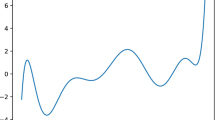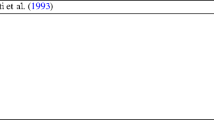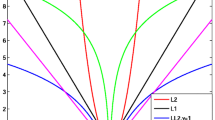Abstract
In this paper, we introduce a computational framework for recovering a high-resolution approximation of an unknown function from its low-resolution indirect measurements as well as high-resolution training observations by merging the frameworks of generalized sampling and functional principal component analysis. In particular, we increase the signal resolution via a data-driven approach, which models the function of interest as a realization of a random field and leverages a training set of observations generated via the same underlying random process. We study the performance of the resulting estimation procedure and show that high-resolution recovery is indeed possible provided appropriate low rank and angle conditions hold and provided the training set is sufficiently large relative to the desired resolution. Moreover, we show that the size of the training set can be reduced by leveraging sparse representations of the functional principal components. Furthermore, the effectiveness of the proposed reconstruction procedure is illustrated by various numerical examples.
Similar content being viewed by others
References
Adcock, B., Gataric, M., Hansen, A.C.: On stable reconstructions from nonuniform Fourier measurements. SIAM J. Imaging Sci. 7(3), 1690–1723 (2014a)
Adcock, B., Gataric, M., Romero, J.L.: Computing reconstructions from nonuniform Fourier samples: Universality of stability barriers and stable sampling rates. Appl. Comput. Harmon. Anal. 46(2), 226–249 (2019)
Adcock, B., Hansen, A.C.: A generalized sampling theorem for stable reconstructions in arbitrary bases. J. Fourier Anal. Appl. 18(4), 685–716 (2012)
Adcock, B., Hansen, A.C.: Generalized sampling and infinite-dimensional compressed sensing. Found. Comput. Math. 16(5), 1263–1323 (2016)
Adcock, B., Hansen, A.C., Kutyniok, G., Ma, J.: Linear stable sampling rate: Optimality of 2D wavelet reconstructions from Fourier measurements. SIAM J. Math. Anal. 47(2), 1196–1233 (2015)
Adcock, B., Hansen, A.C., Poon, C.: Beyond consistent reconstructions: Optimality and sharp bounds for generalized sampling, and application to the uniform resampling problem. SIAM J. Math. Anal. 45(5), 3132–3167 (2013)
Adcock, B., Hansen, A.C., Poon, C.: On optimal wavelet reconstructions from Fourier samples: Linearity and universality of the stable sampling rate. Appl. Comput. Harmon. Anal. 36(3), 387–415 (2014b)
Adcock, B., Hansen, A.C., Poon, C., Roman, B.: Breaking the coherence barrier: A new theory for compressed sensing. Forum of Math. Sigma 5, e4 (2017)
Arridge, S., Maass, P., Öktem, O., Schönlieb, C.-B.: Solving inverse problems using data-driven models. Acta Numerica 28, 1–174 (2019)
Babuška, I., Osborn, J.: Estimates for the errors in eigenvalue and eigenvector approximation by Galerkin methods, with particular attention to the case of multiple eigenvalues. SIAM J. Numer. Anal. 24(6), 1249–1276 (1987)
Baker, S., Kanade, T.: Hallucinating faces. In: Proceedings Fourth IEEE International Conference on Automatic Face and Gesture Recognition (Cat. No. PR00580), pp 83–88 (2000)
Blu, T., Dragotti, P., Vetterli, M., Marziliano, P., Coulot, L.: Sparse sampling of signal innovations. IEEE Signal Process. Mag. 25(2), 31–40 (2008)
Candès, E.J., Fernandez-Granda, C.: Towards a mathematical theory of super-resolution. Commun. Pure Appl. Math. 67(6), 906–956 (2014)
Candės, E.J., Romberg, J., Tao, T.: Robust uncertainty principles: exact signal reconstruction from highly incomplete frequency information. IEEE Trans. Inf. Theory 52(2), 489–509 (2006)
Capel, D., Zisserman, A.: Super-resolution from multiple views using learnt image models. In: Proceedings of the 2001 IEEE Computer Society Conference on Computer Vision and Pattern Recognition. CVPR 2001, vol. 2 (2001)
Chiew, M., Graedel, N.N., McNab, J.A., Smith, S.M., Miller, K.L.: Accelerating functional MRI using fixed-rank approximations and radial-cartesian sampling. Magn. Reson. Med. 76(6), 1825–1836 (2016)
Cohen, A., Daubechies, I., Vial, P.: Wavelets on the interval and fast wavelet transforms. Appl. Comput. Harmonic Anal. 1(1), 54–81 (1993)
Cohen, A., Davenport, M.A., Leviatan, D.: On the stability and accuracy of least squares approximations. FoCM 13(5), 819–834 (2013)
d’Aspremont, A., El Ghaoui, L., Jordan, M.I., Lanckriet, G.R.G.: A direct formulation for sparse PCA using semidefinite programming. SIAM Rev. 49(3), 434–448 (2007)
Davis, C., Kahan, W.M.: The rotation of eigenvectors by a perturbation. III. SIAM J. Numer. Anal. 7(1), 1–46 (1970)
Donoho, D.L.: Compressed sensing. IEEE Trans. Inf. Theory 52 (4), 1289–1306 (2006)
Eldar, Y.C.: Sampling with arbitrary sampling andreconstruction spaces and oblique dual frame vectors. J. Fourier Anal. Appl., 77–96 (2003)
Gataric, M., Gordon, G.S.D., Renna, F., Ramos, A.G.C.P., Alcolea, M.P., Bohndiek, S.E.: Reconstruction of optical vector-fields with applications in endoscopic imaging. IEEE Trans. Med. Imaging 38(4), 955–967 (2019)
Gataric, M., Poon, C.: A practical guide to the recovery of wavelet coefficients from Fourier measurements. SIAM J. Sci. Comput. 38(2), A1075–A1099 (2016)
Gataric, M., Wang, T., Samworth, R.J.: Sparse principal component analysis via axis-aligned random projections. J. R. Stat. Soc. Ser. B (2020)
Gunturk, B.K., Batur, A.U., Altunbasak, Y., Hayes, M.H., Mersereau, R.M.: Eigenface-domain super-resolution for face recognition. IEEE Trans. Image Process. 12(5), 597–606 (2003)
Hall, P., Muller, H.-G., Wang, J.-L.: Properties of principal component methods for functional and longitudinal data analysis. Ann. Stat. 34 (3), 1493–1517 (2006)
Hrycak, T., Gröchenig, K.: Pseudospectral fourier reconstruction with the modified inverse polynomial reconstruction method. J. Comput. Phys. 229(3), 933–946 (2010)
Hsu, D., Kakade, S.M., Zhang, T.: Random design analysis of ridge regression. In: Mannor, S., Srebro, N., Williamson, R.C. (eds.) Proceedings of the 25th Annual Conference on Learning Theory. Edinburgh, Scotland, vol. 23, pp 9.1–9.24 (2012a)
Hsu, D., Kakade, S.M., Zhang, T.: A tail inequality for quadratic forms of subgaussian random vectors. Electron. Commun. Probab. 17(52), 6 (2012b)
Johnstone, I.M., Lu, A.Y.: On consistency and sparsity for principal components analysis in high dimensions. J. Am. Stat. Assoc. 104(486), 682–693 (2009)
Joly, E., Lugosi, G., Oliveira, R.I.: On the estimation of the mean of a random vector. Electron. J. Stat. 11(1), 440–451 (2017)
Koltchinskii, V., Lounici, K.: Concentration inequalities and moment bounds for sample covariance operators. Bernoulli 23(1), 110–133 (2017a)
Koltchinskii, V., Lounici, K.: New asymptotic results in principal component analysis. Sankhya A 79(2) (2017b)
Lila, E., Arridge, S., Aston, J.A.D.: Representation and reconstruction of covariance operators in linear inverse problems (2019)
Lingala, S.G., Hu, Y., DiBella, E., Jacob, M.: Accelerated dynamic mri exploiting sparsity and low-rank structure: k-t SLR. IEEE Trans. Med. Imaging 30(5), 1042–1054 (2011)
Liu, C., Shum, H. -Y., Freeman, W.T.: Face Hallucination: Theory and Practice. Int. J. Comput. Vis. 75, 115–134 (2007)
Ma, Z.: Sparse principal component analysis and iterative thresholding. Ann. Stat. 41(2), 772–801 (2013)
Mallat, S.: A Wavelet Tour of Signal Processing, Third Edition: The Sparse Way, 3rd edn. Academic Press, Inc., Orlando (2008)
Ramsay, J., Silverman, B.W.: Functional Data Analysis. Springer Series in Statistics. Springer, Berlin (2005)
Ravishankar, S., Ye, J.C., Fessler, J.A.: Image reconstruction: From sparsity to data-adaptive methods and machine learning. Proc. IEEE 108, 86–109 (2019)
Shannon, C.E.: A mathematical theory of communication. Bell Syst. Tech. J. 27(3), 379–423 (1948)
Unser, M., Aldroubi, A.: A general sampling theory for nonideal acquisition devices. IEEE Trans. Signal Process. 42(11), 2915–2925 (1994)
Vu, V.Q., Lei, J.: Minimax sparse principal subspace estimation in high dimensions. Ann. Stat. 41(6), 2905–2947 (2013)
Wang, T., Berthet, Q., Samworth, R.J.: Statistical and computational trade-offs in estimation of sparse principal components. Ann. Stat. 44 (5), 1896–1930 (2016)
Weyl, H.: Das asymptotische Verteilungsgesetz der Eigenwerte linearer partieller Differentialgleichungen (mit einer Anwendung auf die Theorie der Hohlraumstrahlung). Math. Ann., 441–479 (1912)
Yang, J., Wright, J., Huang, T.S., Ma, Y.: Image super-resolution via sparse representation. IEEE Trans. Image Process. 19(11), 2861–2873 (2010)
Zhao, B., Haldar, J.P., Christodoulou, A.G., Liang, Z.: Image reconstruction from highly undersampled (k, t)-space data with joint partial separability and sparsity constraints. IEEE Trans. Med. Imaging 31(9), 1809–1820 (2012)
Zhao, B., Setsompop, K., Adalsteinsson, E., Gagoski, B., Ye, H., Ma, D., Jiang, Y., Ellen Grant, P., Griswold, M.A., Wald, L.L.: Improved magnetic resonance fingerprinting reconstruction with low-rank and subspace modeling. Magn. Reson. Med. 79(2), 933–942 (2018)
Zou, H., Hastie, T., Tibshirani, R.: Sparse principal component analysis. J. Comput. Graph. Stat. 15(2), 265–286 (2006)
Acknowledgements
The author would like to thank Ben Adcock, Clarice Poon, Alberto Gil Ramos, Richard Samworth and Carola-Bibiane Schönlieb for useful discussions and comments.
Funding
The author was supported by an EPSRC grant EP/N014588/1 for the Centre for Mathematical and Statistical Analysis of Multimodal Clinical Imaging.
Author information
Authors and Affiliations
Corresponding author
Ethics declarations
Conflict of interest
The author declares no competing interests.
Additional information
Communicated by: Felix Krahmer
Publisher’s note
Springer Nature remains neutral with regard to jurisdictional claims in published maps and institutional affiliations.
Appendix. Proofs of theoretical results
Appendix. Proofs of theoretical results
Proof of Lemma 1
Observe that \(\sin \limits \angle (\mathcal {E}_{m},\hat {\mathcal {E}}^{p}_{m})\leq \sin \limits \angle (\mathcal {E}_{m},\mathcal {E}^{p}_{m}) + \sin \limits \angle (\mathcal {E}^{p}_{m},\hat {\mathcal {E}}^{p}_{m}),\) where \(\mathcal {E}^{p}_{m}:=\text {span}\{{\phi _{1}^{p}},\ldots ,{\phi _{m}^{p}}\}\) and \(\{({\phi _{j}^{p}},{\lambda _{j}^{p}})\}_{j=1}^{p}\) are the eigenfunction-eigenvalue pairs of the covariance operator Kp associated to the random variable \(Q_{\mathcal {G}_{p}}F\). Recall that \({e^{p}_{j}}:=(\langle {\phi _{j}^{p}} ,\varphi _{1} \rangle ,\ldots , \langle {\phi _{j}^{p}} ,\varphi _{p} \rangle )^{\top }\) is an eigenvector of ΣX with eigenvalue \({\lambda _{j}^{p}}\). To upper-bound \(\sin \limits \angle (\mathcal {E}_{m},\mathcal {E}^{p}_{m})\), first note that for any k,j = 1,…,p, we have
where we used \({\lambda ^{p}_{j}} {e^{p}_{j}}={\Sigma }_{X} {e^{p}_{j}}\) and \( {\Sigma }_{X}^{(k,\ell )}=\mathbb {E} [ \langle F-\mu , \varphi _{k} \rangle \overline { \langle F-\mu , \varphi _{\ell }} \rangle ] = {\sum }_{j\in \mathbb {N}}\lambda _{j} \langle \phi _{j}, \varphi _{k} \rangle \overline {\langle \phi _{j}, \varphi _{\ell } \rangle } = {\int \limits }_{D}{\int \limits }_{D} K(u,v) \overline {\varphi _{k}(u)}\varphi _{\ell }(v) \mathrm {d} u \mathrm {d} v\), k,ℓ = 1,…,p, as well as the fact that \({\phi _{j}^{p}}={\sum }_{\ell =1}^{p}\langle {\phi _{j}^{p}},\varphi _{\ell } \rangle \varphi _{\ell }\), respectively. Therefore
Since also \(\lambda _{j} {\int \limits }_{D} \phi _{j}(v) \overline {f(v)} \mathrm {d} v = {\int \limits }_{D}{\int \limits }_{D} K(u,v) \phi _{j}(u) \overline {f(v)} \mathrm {d} u \mathrm {d} v\), \(\forall f\in {\mathscr{L}}_{2}(D;\mathbb {C})\), by the approximation properties of the Galerkin method [10], we have \({\lambda _{j}^{p}}\leq \lambda _{j}\), and moreover, there exist C (independent of p) and p0 such that for any p ≥ p0 and j = 1,…,m, we have
Now, let ej := (〈ϕj,φ1〉,〈ϕj,φ2〉,…)⊤, \(E_{m} := (e_{1}, \ldots , e_{m}) \in \mathbb {C}^{\infty \times m}\) and \({E_{m}^{p}} := ({e_{1}^{p}}, \ldots , {e_{m}^{p}}) \in \mathbb {C}^{p\times m}\). Let \(Q_{p}\in \mathbb {C}^{p\times \infty }\) denote the projection operator with identity Ip constituting the first p columns and the rest equal to zero, and let \({\Theta }({E_{m}^{p}},Q_{p}E_{m})\) denote the m × m diagonal matrix whose j th diagonal entry is \(\arccos \) of the j th singular value of \(({E_{m}^{p}})^{\top } Q_{p} E_{m}\). Observe that \(\langle \phi _{j},{\phi _{k}^{p}} \rangle ={\sum }_{\ell =1}^{p} \langle \phi _{j},\varphi _{\ell } \rangle \langle {\phi _{k}^{p}},\varphi _{\ell } \rangle = ({e_{k}^{p}})^{\top } Q_{p} e_{j}\). Therefore, we have
where in the last inequality we used (26). To conclude part (a) of the proof, it remains to upper-bound \(\sin \limits \angle (\mathcal {E}^{p}_{m},\hat {\mathcal {E}}^{p}_{m})\). Similarly as above, let \(\hat {E}_{m}^{p} := (\hat {e}_{1}^{p}, \ldots , \hat {e}_{m}^{p}) \in \mathbb {C}^{p\times m}\), and let \({\Theta }(\hat {E}_{m}^{p},{E_{m}^{p}})\) denote the m × m diagonal matrix whose j th diagonal entry is \(\arccos \) of the j th singular value of \((\hat {E}_{m}^{p})^{\top } {E_{m}^{p}}\). Since \({\langle \phi ^{p}_{j}},{\hat \phi ^{p}_{k}}\rangle = (\hat {e}^{p}_{k})^{\top }{e^{p}_{j}}\), we have \(\sin \limits \angle ({\mathcal {E}}^{p}_{m},\hat {\mathcal {E}}^{p}_{m}) = \|{\sin \limits } {\Theta }(\hat {E}_{m}^{p},{E_{m}^{p}})\|_{\text {op}}\), and since \({\Sigma }_{X} {e^{p}_{j}}={\lambda ^{p}_{j}} {e^{p}_{j}}\), we have \({\Sigma }_{Y}{e_{j}^{p}}=({\lambda _{j}^{p}}+\tilde \sigma ^{2}){e_{j}^{p}}\). Thus, due to Davis–Kahan Theorem [20] and Weyl’s inequality [46], provided \(\| \hat {\Sigma }_{Y} - {\Sigma }_{Y} \|_{\text {op}}<({\lambda _{m}^{p}}-\lambda _{m+1}^{p})/2\) holds, we have
Due to result by [33], there exists \(\tilde C\) so that for any \(\delta \geq \exp (-n)\), the inequality
holds with probability at least 1 − δ, and thus, if \(2\tilde {C} ({\lambda _{1}^{p}}+\tilde \sigma ^{2})(\sqrt {p/n}+\sqrt {\log (1/\delta )/n}) <{\lambda _{m}^{p}}-\lambda _{m+1}^{p}\), then
holds with probability at least 1 − 2δ. Moreover, due to (25) and the fact that \({\lambda ^{p}_{j}}\leq \lambda _{j}\), we have \({\lambda _{m}^{p}}-\lambda _{m+1}^{p} \geq \lambda _{m}-\lambda _{m+1} - C {\lambda _{m}^{2}} {\epsilon _{p}^{2}}\) and \( {\lambda ^{p}_{1}}+\tilde \sigma ^{2} \leq \lambda _{1}+\tilde \sigma ^{2}\), so the result (a) follows. For part (b), since \(\mu _{p}=Q_{\mathcal {G}_{p}}\mu = (\varphi _{1},\ldots ,\varphi _{p}) \mu _{X}= (\varphi _{1},\ldots ,\varphi _{p})\mu _{Y}\), we have
with probability at least \(1-\delta ^{\prime }\), where in the last inequality we used the result by [32]. The final result then follows by using that \({\lambda ^{p}_{1}}\leq \lambda _{1}\). □
Proof of Theorem 2
First observe that for any \(f\in {\mathscr{L}}_{2}(D;\mathbb {C})\) we have
Since \(\cos \limits \angle (\hat {\mathcal {E}}^{p}_{m},\mathcal {F}_{q})\geq 1 - \sup _{\substack {\{f\in \hat {\mathcal {E}}^{p}_{m}: \|f\|=1\}}} \|Q_{\mathcal {F}_{q}^{\perp }} f\| \), by using the above inequality we get
Define the event \({\Omega }:=\{\sin \limits \angle (\mathcal {E}_{m},\hat {\mathcal {E}}_{m}^{p})\leq \tilde \epsilon _{mpn\delta }\}\), which due to Lemma 1(a) is the event of probability at least 1 − δ. Due to 27 and since \(\sin \limits \angle (\mathcal {E}_{m},\mathcal {F}_{q})<1-\tilde \epsilon _{mpn\delta }\), on Ω we have \( \cos \limits \angle (\hat {\mathcal {E}}^{p}_{m},\mathcal {F}_{q}) > 0. \) Now define \(\tilde {F}_{0}= {\sum }_{j=1}^{m} \tilde \alpha _{j} \hat {\phi _{j}^{p}}\) such that
On Ω, by the GS result (5) and bound (27), we have
Observe that
Define the event \({\Omega }^{\prime }=\{\|\mu -\hat \mu _{p}\|_{2}\leq \bar \epsilon _{np\delta ^{\prime }} \}\), which due to Lemma 1(b) happens with probability \(1-\delta ^{\prime }\). Then, due to 29 and 30, on \({\Omega }\cap {\Omega }^{\prime }\) we have
Finally, define \({\Omega }^{\prime \prime }:=\bigl \{ \|\hat \alpha - \tilde \alpha \|_{2} \leq \sec \angle (\hat {\mathcal {E}}^{p}_{m},\mathcal {F}_{q}) \sigma \sqrt {(2m+2\log (1/\delta ^{\prime \prime })) /(qr_{1})} \bigr \}\), where vector \(\tilde \alpha =(\tilde \alpha _{1},\ldots ,\tilde \alpha _{m})^{\top }\) is defined as in (26) and \(\hat \alpha =(\hat \alpha _{1},\ldots ,\hat \alpha _{m})^{\top }\) is as in (19). On \({\Omega }\cap {\Omega }^{\prime }\), the probability of \({\Omega }^{\prime \prime }\) conditional on F1,…,Fn,Z1,…,Zn (so that we are in the setting of a fixed design matrix) is at least \(1 - \delta ^{\prime \prime }\), due to the result from [30]. Also, since 31 and
the required bound holds on \({\Omega }\cap {\Omega }^{\prime }\cap {\Omega }^{\prime \prime }\), which has the probability at least \(1 - \delta - \delta ^{\prime } - \delta ^{\prime \prime }\) because \(\mathbb {P}({\Omega } \cap {\Omega }^{\prime } \cap {\Omega }^{\prime \prime }) \geq 1- \mathbb {P}(({\Omega } \cap {\Omega }^{\prime })^{\mathrm {c}}) -\) . □
. □
Rights and permissions
About this article
Cite this article
Gataric, M. High-resolution signal recovery via generalized sampling and functional principal component analysis. Adv Comput Math 47, 84 (2021). https://doi.org/10.1007/s10444-021-09908-0
Received:
Accepted:
Published:
DOI: https://doi.org/10.1007/s10444-021-09908-0
Keywords
- High-dimensional reconstructions
- Sparse PCA
- Wavelet reconstructions
- Fourier sampling
- Data-driven inverse problems
- Low-rank recovery models
- Super-resolution




